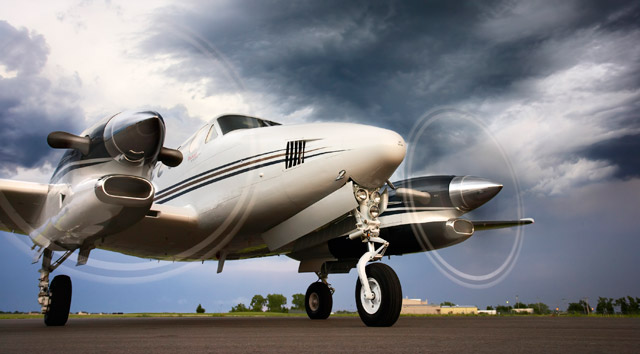Nine months after seeking bankruptcy court protection from a mountain of debt, Beechcraft Corp. announced Feb. 19 that the company has emerged from Chapter 11, minus the “Hawker” name and the business jet production lines attached to that name.
Emergence from Chapter 11 followed a plan laid out in pieces since the court papers were filed May 3, 2012: roughly $1.9 billion in debt eliminated (either wiped from the books or converted to equity in the new company); business jet production halted (along with warranty coverage for the Hawker 4000 and Premier 1 and 1A models); piston and turboprop production to continue.
Executive Vice President of Customers Shawn Vick summed it up: “We eliminated the jet production, and we eliminated the debt.”
In a news release, CEO Bill Boisture said the future will be focused on King Air, Baron and Bonanza lines, along with the T-6 military trainer and light attack aircraft, and “the largest global customer support network in the industry” will continue to serve all aircraft sold to date.
“With these elements as our foundation for the future, we will compete worldwide and we will win,” Boisture said.
Aviation analyst Richard Aboulafia of the Teal Group is not so sure Beechcraft is well-positioned to succeed on its own, but elimination of debt and preservation of the lucrative support business make Beechcraft a tempting target for takeover.
“It’s tough to survive as a niche player,” Aboulafia said. “There’s a good chance that somebody would want them.”
 King Air C90 GT.
King Air C90 GT.
Boisture returned to the chief executive role after being replaced by the Hawker Beechcraft board a few months before the company filed for bankruptcy. Boisture continued to serve as chairman, and resumed his role as chief executive with conclusion of the case. Vick, in charge of all aspects of customer relations, was the executive fielding questions from the press on Feb. 19. Vick said there were several reasons why the slimmed down Beechcraft (the company has reduced its “footprint” by 40 percent, he noted) is positioned to succeed.
“Let’s start with an installed base of 36,000 airplanes, and an iconic brand in Beechcraft recognized the world over,” Vick said, adding that the twin turboprop King Air has few true comparables to compete against, and is positioned to draw customers who might otherwise opt for a small jet.
Vick said the company continues a dialogue with customers and potential customers to assess the viability of producing a brand-new single-engine turboprop, a clean-sheet design that will live or die based on demand. The company is still working to determine what the market needs, and what buyers would pay for it, and there is no certain timeline for the new turboprop, yet.
“We think the timing of any product launch has to be concurrent with a marketplace that’s going to reward us for that investment,” Vick said in a telephone interview (he was interviewed separately for AOPA Live This Week).
While business jet production has ceased, Vick said the company will continue to offer parts and service for the roughly 3,000 jets currently in service, along with the 33,000 turboprops and pistons.
Warranty coverage for the 900XP, 750, and 400XP jets will continue, though the company sought and secured court approval to cancel warranty coverage for Hawker 4000 and Premier 1 and 1A models, along with an upgrade and enhancement program for early editions of the Hawker 4000.
The court approved the request in January over some objections, and a spokeswoman said the company is in contact with customers whose aircraft had not completed the Hawker 4000 upgrade previously offered free to early adopters (with an estimated value of $700,000) to discuss a timeline for “the upgrades that will be made available.”
Aboulafia said the warranty cancellation may have a lingering effect on demand for Beechcraft products.
“Winding up with an orphan plane is a big fear people have when buying from a small, niche company,” Aboulafia said. “It might linger a few years.”
Vick said there has been “demonstrated interest” by two companies in acquiring type certificates for out-of-production jets, but talks to date have not produced any agreement and the company has no active conversations going on that topic.
“Our position on that has been: In the event a qualified, experienced, well-capitalized entity … who specialize in the service and support of out-of-production aircraft” makes an offer, “we will, of course, have the discussion,” Vick said. “That has to be something that we are confident is the right thing for that installed base.”
Vick said the company has a development plan in place for the piston lines as well.
“Now that we have concluded the restructuring, we’re able to begin investing again in the product development for the pistons,” Vick said.
The company announced Feb. 19 it has secured $600 million in permanent financing, including $425 million to repay short-term “debtor in possession” financing and other bankruptcy costs. A portion of that, along with a $175 million line of credit, will finance ongoing operations. That debt is a fraction of the $2.5 billion owed prior to bankruptcy, which combined with a downturn in demand to drive the company to the financial edge.
Vick said elimination of the jets “eliminates loss-making products.” Attention now turns to turning out propeller-driven models in increasing numbers.
 A Beechcraft King Air C90 GT, seen here with thunderstorms over Beech Field in Wichita, Kan. The company hopes the financial storm now ended with emergence from bankruptcy will give way to a smoother ride for the turboprops and pistons that remain.
A Beechcraft King Air C90 GT, seen here with thunderstorms over Beech Field in Wichita, Kan. The company hopes the financial storm now ended with emergence from bankruptcy will give way to a smoother ride for the turboprops and pistons that remain.



